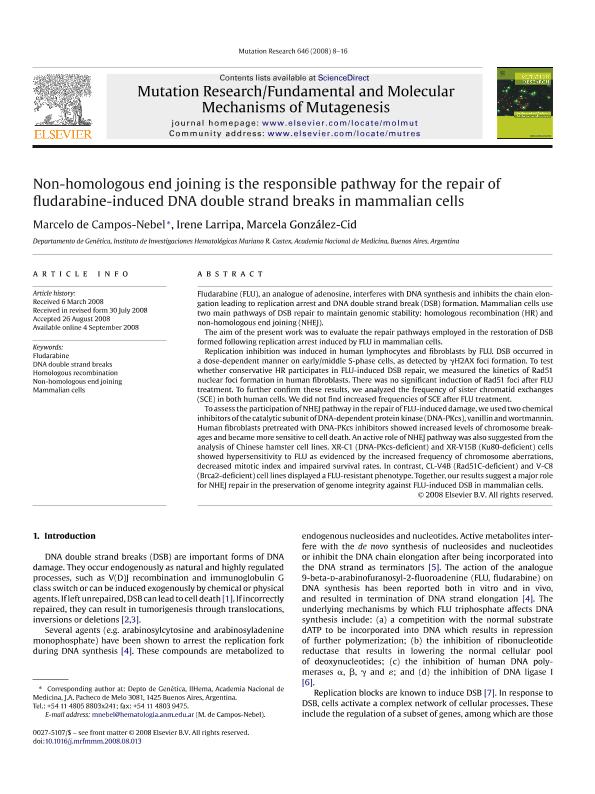Artículo
Non-homologous end joining is the responsible pathway for the repair of fludarabine-induced DNA double strand breaks in mammalian cells
Fecha de publicación:
11/2008
Editorial:
Elsevier Science
Revista:
Mutation Research-fundamental And Molecular Mechanisms Of Mutagenesis
ISSN:
0027-5107
Idioma:
Inglés
Tipo de recurso:
Artículo publicado
Clasificación temática:
Resumen
Fludarabine (FLU), an analogue of adenosine, interferes with DNA synthesis and inhibits the chain elongation leading to replication arrest and DNA double strand break (DSB) formation. Mammalian cells use two main pathways of DSB repair to maintain genomic stability: homologous recombination (HR) and non-homologous end joining (NHEJ). The aim of the present work was to evaluate the repair pathways employed in the restoration of DSB formed following replication arrest induced by FLU in mammalian cells. Replication inhibition was induced in human lymphocytes and fibroblasts by FLU. DSB occurred in a dose-dependent manner on early/middle S-phase cells, as detected by γH2AX foci formation. To test whether conservative HR participates in FLU-induced DSB repair, we measured the kinetics of Rad51 nuclear foci formation in human fibroblasts. There was no significant induction of Rad51 foci after FLU treatment. To further confirm these results, we analyzed the frequency of sister chromatid exchanges (SCE) in both human cells. We did not find increased frequencies of SCE after FLU treatment. To assess the participation of NHEJ pathway in the repair of FLU-induced damage, we used two chemical inhibitors of the catalytic subunit of DNA-dependent protein kinase (DNA-PKcs), vanillin and wortmannin. Human fibroblasts pretreated with DNA-PKcs inhibitors showed increased levels of chromosome breakages and became more sensitive to cell death. An active role of NHEJ pathway was also suggested from the analysis of Chinese hamster cell lines. XR-C1 (DNA-PKcs-deficient) and XR-V15B (Ku80-deficient) cells showed hypersensitivity to FLU as evidenced by the increased frequency of chromosome aberrations, decreased mitotic index and impaired survival rates. In contrast, CL-V4B (Rad51C-deficient) and V-C8 (Brca2-deficient) cell lines displayed a FLU-resistant phenotype. Together, our results suggest a major role for NHEJ repair in the preservation of genome integrity against FLU-induced DSB in mammalian cells. © 2008 Elsevier B.V. All rights reserved.
Archivos asociados
Licencia
Identificadores
Colecciones
Articulos(IMEX)
Articulos de INST.DE MEDICINA EXPERIMENTAL
Articulos de INST.DE MEDICINA EXPERIMENTAL
Citación
de Campos Nebel, Ildefonso Marcelo; Larripa, Irene Beatriz; Gonzalez Cid, Marcela Beatriz; Non-homologous end joining is the responsible pathway for the repair of fludarabine-induced DNA double strand breaks in mammalian cells; Elsevier Science; Mutation Research-fundamental And Molecular Mechanisms Of Mutagenesis; 646; 1-2; 11-2008; 8-16
Compartir
Altmétricas




